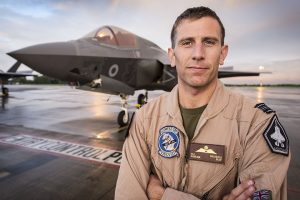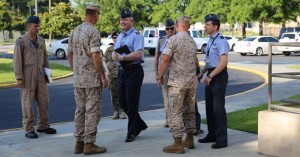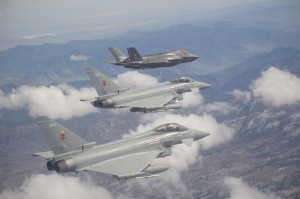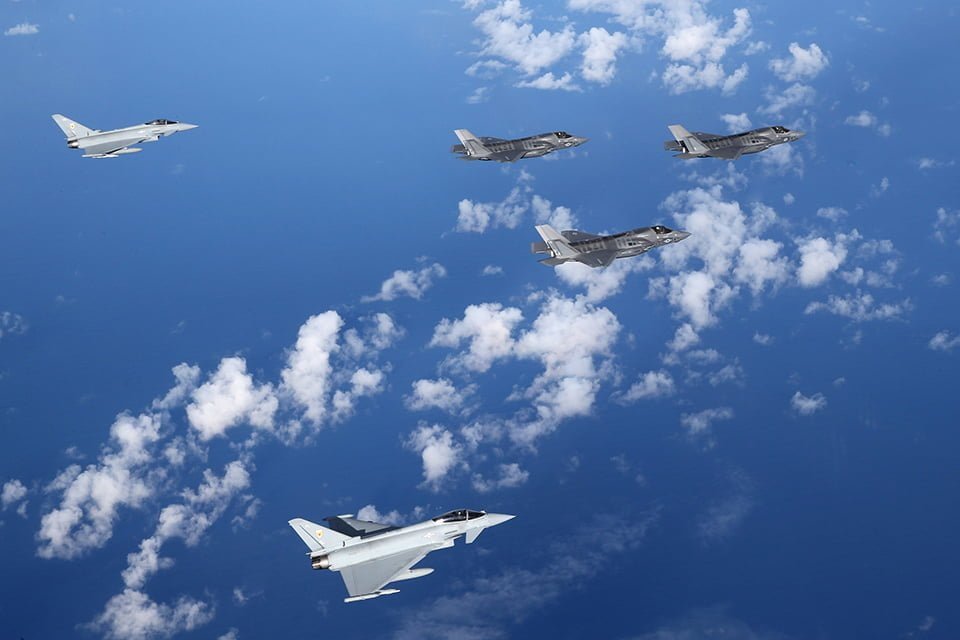2016-07-18 By Robbin Laird
USMC and RAF F-35Bs flew from USMC Beaufort Air Station to participate in the RIAT and Farnbourgh air shows.
USAF sent F-35As across the Atlantic to participate as well in RIAT. These flights are the latest trans-Atlantic crossings with the Italians coming first on February 5th with a landing at Pax River and then with later flights as well to Luke AFB bringing Italian build F-35s across the Atlantic.
The Dutch were next flying from Edwards AFB to the Netherlands.
These flights are simply part of the process of standing up the F-35 enterprise in the extended defense of Europe and the North Atlantic.
Put simply, the simultaneous standup of F-35s in the UK by the RAF and the USAF, the coming of the F-35Bs to the new British carriers, the F-35Cs to US aircraft carriers, of F-35As to Norway, Denmark and the Netherlands provides a key opportunity for synergy in shaping the extended defense of NATO.
With the same combat systems operating across the force, and the sharing of data across that force, a significant capability is being stood up from the beginning to provide for the common defense.
This is a work in progress and will take significant effort and innovation. It will be about opening the aperture on thinking about common infrastructure, shared logistics, and cross-cutting combat learning and innovation.
But it is inherent in flying a common airplane, that the pilots, maintainers and airpower leaders associated with the F-35 can figure it out.
We hear often about the need for NATO to enhance its defense capabilities; yet one key means for doing so is simply staring NATO in the face, namely leveraging a common fifth generation aircraft and reshaping the capabilities of the entire combat force.
This has been recognized by key organizations such as the European Air Group or the NATO Joint Air Competence Center (JAPCC). The European Air Group, based at High Wycombe in the UK, is an advisory group to the 7 key European Air Forces, and they are working on ways to shape 4th-5th generation integration.
The JAPCC is based in Germany and is working on how airpower was changing with the operations of fifth generation aircraft and the co-evolution of legacy systems with the augmentation of the role of fifth generation aircraft with the F-35 operating with the Marines and shortly by the USAF.
https://sldinfo.com/reshaping-operational-and-training-approaches-airpower-led-combat-innovation/
The con-ops rethink is driven by the practical experiences rooted in the common effort to standup US and allied F-35s.
In fact, when we interviewed Squadron Leader Hugh Nichols, the RAF pilot who flew the UK F-35 recently to the UK, at USMC Beaufort Air Station last year, he underscored what the joint standup with the USMC meant.
“The Marines have done a fantastic job working through previous program difficulties and have blazed a trail towards bringing this next generation capability into service. They are Marines, and if anything gets in the way, they deal with it.
“Working with them will clearly ensure that we are ready for the Queen Elizabeth.
“And the pooling agreement is important in terms of cross learning. Our young maintainers are working with Marine Corps maintainers and they are learning to work through different procedures and protocols to learn how to maintain a common airplane….

“The Marines could fly jets off of the Queen Elizabeth and we off the Wasp or other ships the USMC enable for F-35B use in the future.”
The F-35s flying in the skies above the UK are simply a step in what could well be a significant launch point towards enhanced NATO synergy and capability.
The two UK airbases where F-35s will be based, RAF F-35s at RAF Marham and USAF F-35s at RAF Lakenheath, are in very close proximity and the joint training, joint logistics, joint maintenance and joint operational experience will be significant.
And the UK is building facilities at Marham that the USAF will not do but which sharing arrangements can be shaped and worked.
And it is not just about the F-35, but it is about fifth generation enabled combat, and here the ability to fly every day with RAF Typhoons and USAF F-15s along with the new P-8s coming to the RAF along with the entire RAF ISTAR force provides a significant infrastructure for shaping transformation.
In an April interview the head of the RAF F-35 force, Air Commodore Smyth, we discussed the possible synergies and how he saw their impacts.
“It is early days, but we are discussing ways to shape synergy. We already have an excellent working relationship with our USAFE colleagues, and both sides are being very open to exploring ideas.
“But the real opportunity will lie in joint training and some semblance of joint sustainment.

“How do we do training in a more joined up way, both synthetically which is of immediate interest to me, and live with our F-35s because there’s got to be synergy in our approaches in British and European air space. This could then no doubt grow beyond a UK-USAFE relationship, as our close European neighbors establish their F-35s in their countries.
“The next question then is sustainment. What is the appetite from the USAF to want to leverage off what will already be found at RAF Marham as we shape our infrastructure?
“The USAF has operated F-15s at RAF Lakenheath and have used a classic USAF model of flying in parts to sustain their F-15s with C-5s, C-17s and tankers.
“It would make sense to shift to a new model whereby our F-35s shared sustainment and parts, transparently between our two bases, which after all are not very far apart.”
Last December, USAFE and the RAF set up a joint working group to work the synergy issue.
This group has met three times to date and will brief initial findings to senior RAF and USAFE leadership later this summer.
A wide gamut of issues are being concerned from training, to ops, to warehousing of parts, and to sharing across a wide spectrum.
When I visited RAF Lakenheath in June, I had a chance to talk with the 48th Wing Commander, Col. Novotny about the strategic opportunities inherent in the joint standup.
He underscored that unlike setting up an F-35 base in the United States, standing one up at RAF Lakenheath was about putting the F-35 into play with the UK, the Norwegians, the Danes and the Dutch.
“We are not flying alone; but joined at the hip.
“We will be flying exactly in the area of interest for which the plane was designed and can fly together, maintain together, and operate together leveraging the air and sea base for which the F-35 B will fly from as well.
“It is a unique and strategic opportunity for the USAF and for the nations.
“I’m glad that we are the first base overseas, but I see there is great potential for two countries to develop in concert, side-by-side, and to set, set the model for joint operations.
“As we get this right, we can bring in the Danes, the Norwegians and Dutch who are close in geography and the Israelis and Italians as well to shape the evolving joint operational culture and approach.

“Before you know it, you’ve got eight countries flying this airplane seamlessly integrated because of the work that Lakenheath and Marham are doing in the 20 nautical miles radius of the two bases.”
He also highlighted the advantages of joint learning by pilots and maintainers associated with the correlated standup at RAF Marham and at RAF Lakenheath.
“We’re talking about exchange opportunities across the logistics enterprise, and among the pilots as well. If you can fly the A you can fly the B; and vice versa; it is an adjustment, not a whole new training process.
“We are looking to have RAF pilots flying USAF jets and vice versa.
“Doing Red Flags requires bring forces to Nellis and expending monies to come to the exercise, clearly an important task notably in learning to fly together in high intensity warfare exercises.
“But what can be shape from the RAF Marham and Lakenheath bases is frequency of operations with core allies flying the same aircraft.
“The same aircraft point can be missed because the UK did not fly F-16s, the Norwegian, the Danes and the Dutch do. And the USAF does not fly Typhoons and Tornados; the UK does. Now they will ALL fly the same aircraft.
“I did two OT assignments and we worked to get into Red Flag when we could to do joint training.
“Here we can do that virtually every day. We reach the Dutch training airspace, and can work with the Dutch, with the Brits, with the Germans, with Typhoons, with F3s, with the NATO AWACS.
“We take off and we fly 30 minutes to the east and we make it happen. It is Red Flag as regular menu; rather than scheduling a gourmet meal from time to time.
“Most of that learning is done after the sortie.
“Face-to-face interaction, the conversations that are happening in the squadron vaults that happens at Red Flag three weeks out of every two years.
“We will have the opportunity to do that regularly here.
“There is such a unique opportunity here compared to any other place.
“Because every other place which is s going to get into the F-35 program in whatever capacity is going to eventually attempt to develop a little bit of a stovepipe. It happens.
“This is the only place where it’s not the case.
“There’s no other place where we have a maintenance officer who’s run into an issue on Monday at Lakenheath and decides to get in the car and drive 35 minutes to Marham and talk to them and see what they’ve figured out face-to-face.
“Learn to listen.
“Have a bite to eat.
“Be back here by 2:00 in the afternoon with the solution that came from another country.”
https://sldinfo.com/preparing-for-synergy-the-coming-of-the-f-35-to-raf-lakenheath/
A new defense capability is staring NATO in the face as well as for UK and US defense leaders.
The challenge will be to do what one USAF officer noted in discussing the potential for synergy:
“Let’s not talk about what we can or we can’t do.
“What’s right to do?
“Everything can be changed.
“And if it makes sense for us to operate in a different manner, we change the written guidance to support that as long as the leadership is in full agreement.
“We will have to break glass.
Applying yesterday’s procedures and policies to this joint effort makes little sense.”


